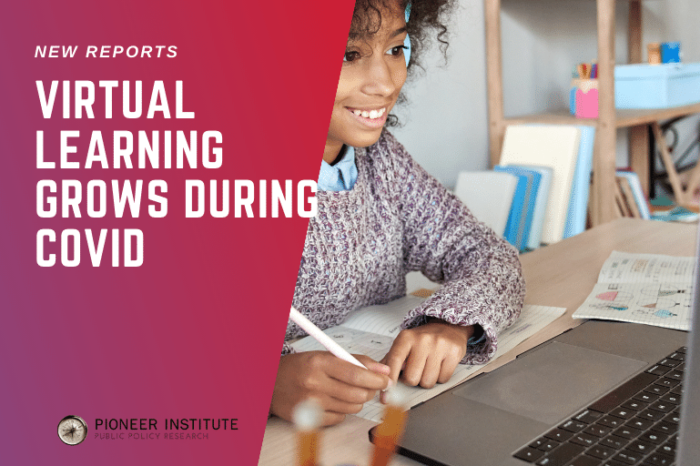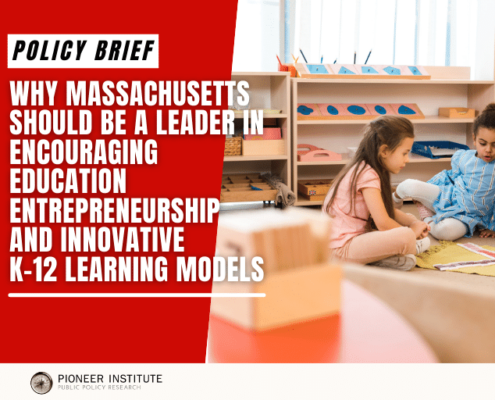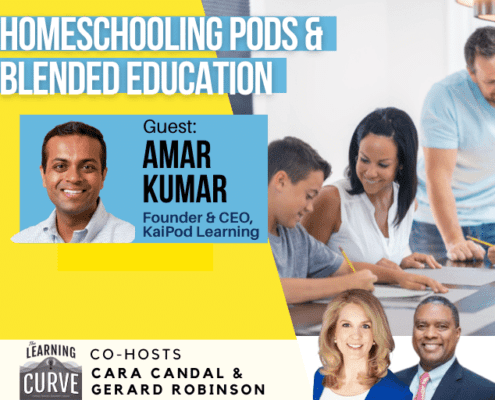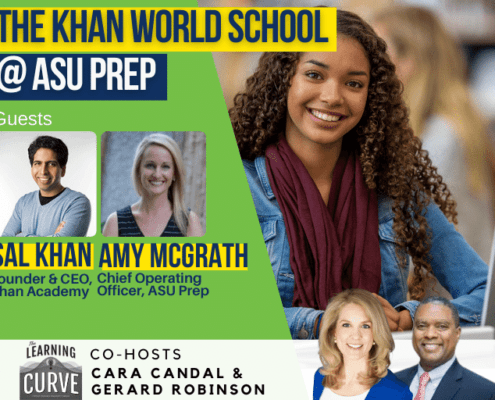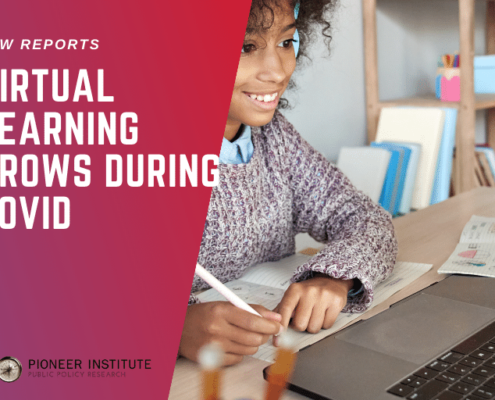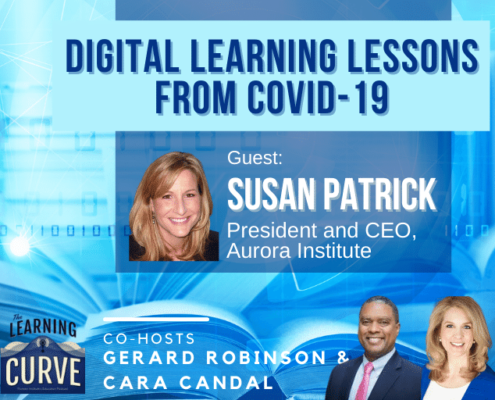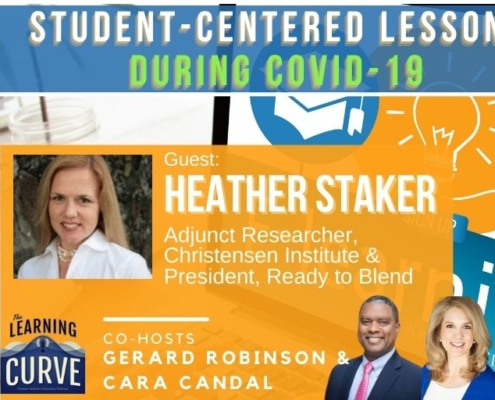Virtual Learning Grows During COVID
Virtual schools are safe and flexible for families and at-risk students
BOSTON – Virtual learning in K-12 education continues to grow due to the health threat caused by coronavirus variants and the assistance this learning model can provide to at-risk students, according to two papers released today by Pioneer Institute.
Though the two factors are distinctly different, their impact is the same, as more families have been prompted to explore the possibilities of digital learning. They have discovered that expert virtual learning differs from what many parents and students experienced after schools unexpectedly shut down in March of 2020. Others have seen how the use of technology can address the unique needs of certain children and high schoolers, the two studies report.
The papers are authored by Julie Young, founder of Florida Virtual School and managing director of Arizona State University Prep Academy and ASU Prep Digital, and William Donovan, a writer and former journalist. The reports also draw on government information, foundation studies, and interviews with experts in the digital learning field.
“Virtual learning, using computers and the internet to study courses taught in the classroom, isn’t meant to replace an in-school education,” says Young. “But it provides a genuine alternative for families who have challenges that interfere with attending brick-and-mortar schools.”
The level of parental demand for remote instruction has declined from the peak of the shutdown surge, as students returned to school full time in 2021. But states and school districts in California, Florida, North Carolina, Utah and elsewhere in the U.S. are continuing to expand their pre-pandemic virtual learning capacity to accommodate further enrollment growth.
In “Virtual Learning, Concrete Option,” the authors explain why established virtual schools and their programs are much different from the frantic switch to remote teaching that schools were forced to make after the 2020 closing. That hasty rush soured virtual learning for many families. True virtual schools apply years of experience to create courses designed for the online platform. Courses are developed by teams of designers, expert in user interface, graphics, instruction, and curriculum.
Most of the more than 330,000 students who attend one of the nearly 500 full-time virtual schools in the U.S. did not experience the same disruptions as in-class students, the authors state.
Virtual learning is a specific form of education that takes place through an online platform. It has often been swapped with the term remote to describe out-of-classroom learning as if they were the same. Virtual learning is much different from what was often a hasty attempt to remotely push classroom instruction through a computer screen when schools were closed. Remote learning is a broad description of what was happening.
In the second paper, “Online and On Course,” Young and Donovan lay out the benefits that virtual learning can provide to at-risk students, particularly minority students and those from low-income families. Those students often face personal or social issues such as violence in school, teenage pregnancy, or the need to work to help support their family. Unable to attend school, many drop out and ultimately fail to graduate.
The primary advantage that digital learning can provide those students is to free them from restrictions that tie learning to set hours in a specific place.
“Too often we limit students in a system in which time is fixed and learning is variable,” says Young. “Online learning flips that system and makes time variable and learning fixed. Enabling students to work at their own time and pace is a way for them to meet their academic requirements and their responsibilities outside of school.”
While touting the virtues, the authors advise parents to scrutinize digital programs closely. Their quality and effectiveness vary widely. Students are poorly served by point-and-click assessments with no engagement, virtual schools with videos instead of real teachers, and programs without pacing and scheduling support.
A key differentiator between questionable and quality virtual programs is adherence to the National Standards for Quality Online Learning, which includes standards for virtual teaching, programs, and courses. A competent virtual program should adhere to those standards.
The papers offer many recommendations, including the need to build out the digital learning infrastructure with broadband access to rural communities; investment in training teachers in virtual instruction; and the need for districts to be more forward-thinking in school designs such as hybrid models, learning pods, and micro-schools.
About the Authors
Julie Young is ASU Vice President of Education Outreach and Student Services and Managing Director of ASU Prep Academy and ASU Prep Digital. She is a visionary CEO, educator, and entrepreneur passionate about leveraging technology and building innovative school models that put students at the center of every decision. Under Julie’s leadership over the last four years, ASU Preparatory Academy has grown exponentially in both enrollment and global impact, currently serving more than 7,500 full-time K–12 students and over 400,000 student enrollments in school partnerships around the U.S. This unique program offers students an accelerated path toward college admission and careers of the future with the chance to earn concurrent high school and university credit, shortening time and cost to degree. Julie was the founding President and CEO of Florida Virtual School (FLVS ®), the world’s first virtual statewide school district that began as a small grant initiative and grew to become the largest public K-12 program in the U.S., serving more than 2 million students in 50 states and 68 countries.
William Donovan is a former staff writer with The Providence Journal in Rhode Island where he wrote about business and government. He has taught business journalism in the graduate programs at Boston University and Northeastern University. He received his undergraduate degree from Boston College and his master’s degree in journalism from American University in Washington, D.C.
About Pioneer
Pioneer’s mission is to develop and communicate dynamic ideas that advance prosperity and a vibrant civic life in Massachusetts and beyond. Pioneer’s vision of success is a state and nation where our people can prosper and our society thrive because we enjoy world-class options in education, healthcare, transportation and economic opportunity, and where our government is limited, accountable and transparent. Pioneer values an America where our citizenry is well-educated and willing to test our beliefs based on facts and the free exchange of ideas, and committed to liberty, personal responsibility, and free enterprise.
Get Updates on Our Education Research
Related Posts:

